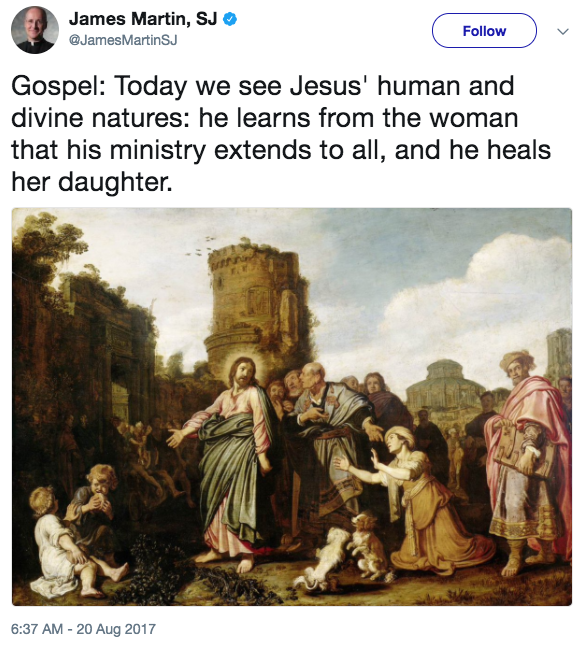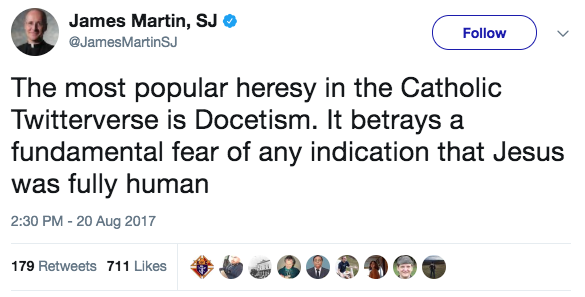The Gospel reading last Sunday was the story of Jesus healing the daughter of the Canaanite woman who came and begged him for help. You can find it at Matthew 5.21-28.
The story can be a bit confusing because Jesus can appear at first to mistreat the woman and then eventually change his mind. But of course, Jesus had no sin, was not prejudiced against the Canaanite woman, and did not learn more about his messianic mission from her either.
Unfortunately, both Maryknoll Missioners and Fr. James Martin tweeted out interpretations of this passage saying those very things.
Here’s what Maryknoll Missioners wrote on Twitter:


Fr. James Martin tweeted something somewhat similar:

When challenged about his theology, Fr. Martin said that those who disagreed with him were guilty of Docetism:

A number of theologians rightly responded to Fr. James Martin’s tweets.
What the Church teaches
First, Jesus was without sin, so the Maryknoll Missioners are wrong: Jesus did not have prejudice against the Canaanite woman that he had to overcome.
Second, contra Fr. James Martin, Jesus didn’t learn anything about his messianic mission from the woman. According to his divine nature, Jesus was omniscient; according to his human nature, his knowledge was not unlimited, and yes he did learn things that people learn from human experience (cf. CCC 472), but he still knew everything about his messianic mission, including that the salvation he offered was for everyone in the whole world.
In fact, Christ himself frequently teaches in the Gospels that he came for the salvation of the whole world (e.g. John 3.16ff, et al.).
Further, the Catechism is clear about the extent of his human knowledge: “By its union to the divine wisdom in the person of the Word incarnate, Christ enjoyed in his human knowledge the fullness of understanding of the eternal plans he had come to reveal. What he admitted to not knowing in this area, he elsewhere declared himself not sent to reveal.” (CCC 474)
So then how are we to understand the story?
The traditional answer is that Jesus was intentionally drawing out the faith of the Canaanite woman, faith he already knew she had.
For example, here’s what St. John Chrysostom, a 4th century Doctor of the Church, said of the passage:
“This was the cause why Christ was so backward, that He knew what she would say, and would not have her so great excellence hid; whence it follows, “Then Jesus answered and said unto her, O woman, great is thy faith, be it unto thee according to thy will.” Observe how the woman herself had contributed not a little to her daughter’s healing; […] Observe how she obtains what the Apostles could not obtain for her; so great a thing is the earnestness of prayer. He would rather that we should pray for our own offences ourselves, than that others should pray for us.”
[See also: When Jesus Stormed the Gates of Hell: The Forgotten Events of Holy Saturday]
[See also: If Jesus Had No Sin, Then Why Was He Baptized? Here’s the Radical Answer]

